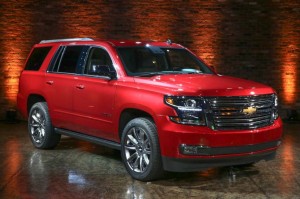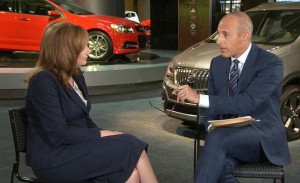
Earnings on new full-size models, such as this 2015 Chevy Tahoe, should boost GM's earnings going forward, analysts forecast.
The fallout from the ignition switch recall and other safety-related problems cut deeply into General Motors’ profitability for the second quarter, the maker reported.
Net income for the March to June period tumbled to just $200 million, or 11 cents per share, compared to a $1.2 billion net for the second quarter of 2013. The GM balance sheet was hammered during the latest period by one-time costs, most of them related to ongoing recalls, as well as for setting up a new victims’ compensation fund. Earnings before the recall-related charges would have been 58 cents a share.
“The ignition switch put tremendous pressure on our earnings,” GM chief executive officer Mary Barray told analysts and reporters. “But nevertheless we remained profitable.”
Barra also said the sweeping recalls, which so far this year cover 29 million units, have not deterred GM from pushing ahead with its effort to improve its competitive position around the world.
(Ford beats earnings estimates for 2nd quarter. Click Here to find out how well it performed.)
“We stayed on our plans. Still interested in building great products and satisfying our customers,” said GM’s first female CEO, noting that while the maker’s global market share declined for the quarter it still managed to sell 2.5 million vehiclesm for its best showing since 2005.
The recall blitz ultimately cost GM about $1.2 billion for the quarter. And though the maker had earlier signaled the worst of its safety problems had passed, it announced another six recalls this week that will take an additional toll on third-quarter numbers. Nonetheless, Barra insisted the maker is “enhancing” its approach to safety, “mining every source of data available” to make sure it isn’t missing additional problems.
The company is facing a series of investigations, including one by the Justice Department, because internal documents reveal it waited as much as a decade or more to address the ignition switch issue that led to the recall of 2.4 million vehicles in February – and which has been linked to at least 13 deaths.
“We want our customers to know if we identify an issue that affects safety we will take action, Barra said. “Our entire organization knows what’s expected of them.”
GM has already fixed more than 550,000 vehicles involved in the ignition switch recall, which covered more than 2.5 million. However, it may be October before the maker’s dealers have enough kits to finish making repairs.
The new compensation fund set up for victims of that defect, meanwhile, will begin accepting claims on August 1st, with fund administrator Kenneth Feinberg hoping to complete the process by early in 2015.
During a conference call with journalists following the release of GM’s second-quarter earnings, Chief Financial Officer Chuck Stevens estimated the ultimate cost will be at least $400 million – and could reach $600 million or more because “there is no cap” on the money available to Feinberg’s team.
(For more on the impact of the victims’ fund and other recall charges, Click Here.)
While recalls might be the most obvious of GM’s current headaches, it does face other issues, notably in Russia and South America. GM’s global market share was hurt by political conflicts that have slowed economic growth in both Russia and Venezuela.
On the other hand, GM’s position in Europe is showing sign of improvement. The maker recently put its German subsidiary, Adam Opel, in charge of all European operations. Despite continuing losses, the Opel brand gained market share in Germany, and is showing signs that its latest turnaround plan is beginning to gain momentum.
That said, after working in additional restructuring charges, GM Europe reported an adjusted $300 million loss during the second-quarter, compared with a $100 million deficit a year earlier.
(GM announces 6 more recalls covering 717,000 vehicles. Click Here for details.)
“Our core operating performance was very good in North America,” Barra said, despite its recall woes.
The maker has defied skeptics who anticipated it would lose sales and shares due to the constant, negative headlines. But it appears to have offset that problem with a flood of new, and generally well-received new models. Influential Consumer Reports magazine, for example, this week heaped praise on the Buick brand, suggesting buyers consider it as a viable alternative to such European luxury makers as BMW.
Chuck Stevens, GM’s chief financial officer, said GM is still on a path to reach its goal of 10% margins. In addition, the second half of 2014 should be stronger than the first half. “The big driver behind that is the launch of the full-size SUVS,” he said, referring to newly redesigned models like the 2015 Chevrolet Tahoe and GMC Yukon Denali.
A report by analyst Ryan Brinkman, at JP Morgan, noted that earnings on those new trucks have gone “through the roof,” jumping as much as $3,000 per vehicle compared to a year ago.
GM said it expects to “normalize” recall costs for the rest of the year at slightly higher amount than earlier forecast. It will also change the way it accounts for potential problems in the future, rolling into its cost estimates for every vehicle it builds an estimate for possible future recall costs.
(Paul A. Eisenstein contributed to this report.)

